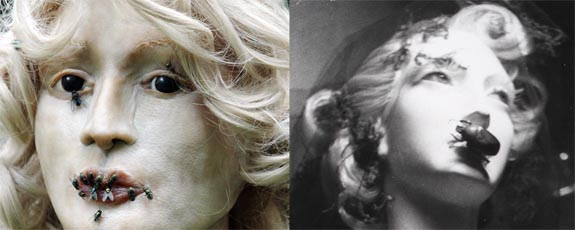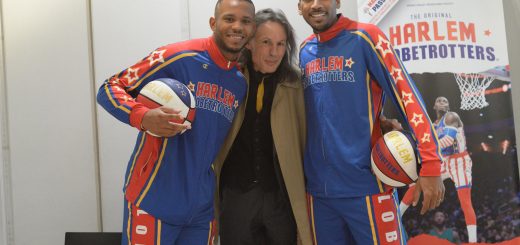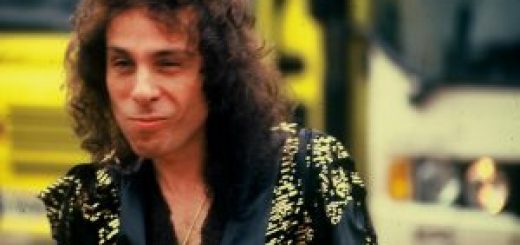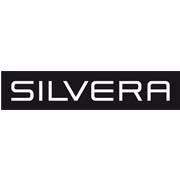UBU GALLERY
2022
| EMIL CADOO Henry Miller’s Sexus: Photomontages, 1963 On view through Friday, July 29th and reopening Tuesday, September 6th In collaboration with Janos Gat Gallery |
||
| First published in 1949 and banned for years, Sexus is acclaimed as one of Henry Miller’s (1891-1980) greatest works. Sexus is the daring first tome of The Rosy Crucifixion, a trilogy that also includes Plexus and Nexus. In this loosely autobiographical series, Miller presents a memoire of his tumultuous life, rich in inner experiences and adventures. Sexus is a story of great love which, through the unforgettable Mara-Mona, acts as a revelation to Miller. It is also the lucid analysis of the formidable crisis which shook him to his core and which catalyzed who he became. Certain passages, very raw and of an exacerbated sexuality, engender provocation. This ardent and powerful work gives testimony to the richness and truth of Miller’s deeply personal creative life.
On June 12, 1964 a Federal Court in Brooklyn put an end to one of the more bizarre episodes of censorship in American history. On that day, three judges condemned police seizure at the bindery of 21,000 copies of Evergreen Review April/May No. 32 as “unconstitutional” and ordered their immediate return to the publisher. The county’s District Attorney had deemed the publication obscene. The issue contained works by Norman Mailer, Jean Genet, William Burroughs, Bryon Gysin, Michael McClure and Karl Shapiro–a who’s who of the day’s practitioners of perceived outrage–but what provoked the seizure was a portfolio of erotic photographs by one Emil Cadoo created in connection with a memorable 1963 edition of Henry Miller’s Sexus published in Paris. |
||
| Emil Cadoo, Sexus, 1963-64, Vintage gelatin silver print, 10 7/8 x 8 1/4 inches, Stamped on verso | ||
| Emil Cadoo (1926-2002) was one of the defining photographers of the Swinging Sixties. His semi-storied career perfectly exemplifies that decade’s lust for change and its commitment to experimentation. Cadoo’s work ranged from high level photojournalism at Life magazine, to Beat generation portraiture, to artistically ambitious and sexually ambiguous erotica.
Born in the Bedford-Stuyvesant section of Brooklyn, Cadoo emigrated to Paris in 1960 and essentially lived there until his death. Cadoo’s energy and personality put him at the center of the expatriate community and he encountered and photographed many of the most important artistic and literary lights of his time. Like his friend and subject James Baldwin, he found easier acceptance in Paris as an African-American and as a homosexual. Paris was also a congenial atmosphere for Cadoo’s interest in erotica. It was there that he created the work he is best known for: his book covers and portfolios for Barney Rosset’s Grove Press and Evergreen Review, which became a cause célèbre in the fight against artistic censorship. Much of Cadoo’s practice was devoted to creating double-exposure photomontages, often combining images of statues, as well as human and botanical forms, with more abstract images of varying textures. Often the double exposures involved erotica, but he did not exclusively rely on the erotic. One of his best-known images, the cover of Jean Genet’s Our Lady of the Flowers, is a simple, elegant, almost somber montage of foliage and a face. Cadoo was a painterly photographer, whose experimental “imagistic duets” contain magical juxtapositions of layer and texture. Always an improviser, the photomontages that Cadoo created for or around Sexus are filled with image upon image that attest to the photographer’s preternatural sense of rhythm and harmony. Combined with the faculty of timing exhibited in his double exposures–which invariably seem to find the decisive syncopated moment–these photomontages mark him as the rare visual artist whose mastery of timing, tempo and texture relates conceptually to Jazz. Cadoo had his first New York exhibition at the Janos Gat Gallery in 2001, just one year before his death. Since then, his photographs have been exhibited at various institutions, such as the Houston Museum of Fine Art (his photographs of the last concert of Edith Piaf) and the Menil Collection also in Houston (his Children of Harlem series). Both museums have large selections of Cadoo’s work, as does the Getty Museum in Los Angeles. |
||
|
|
||
| UBU GALLERY 416 EAST 59 STREET NEW YORK NY 10022 T: 212.753.4444 HOURS: BY APPOINTMENT ONLY FACE COVERINGS ARE REQUIRED INFO@UBUGALLERY.COM WWW. UBU GALLERY eLIST |
||
2020
| INTERWAR LATVIA: An Experiment in Graphic Design & Book Publishing, 1918–1939 On view through July 2, 2021In collaboration with Michael Fagan Fine Art & Rare Books |
||
| Ubu Gallery is pleased to announce the exhibition INTERWAR LATVIA: An Experiment in Graphic Design & Book Publishing, 1918–1939. This is the first presentation in New York which showcases the unique strain of avant-garde and modernist developments that emerged in Latvia during the interwar period. Latvia became a new Republic in 1920 after centuries of foreign domination and eagerly sought new cultural forms to accommodate its vision of independence and its unique language and culture. The period was highlighted by a bounty of experimentation in the arts and literature, which were strongly interrelated and inseparably interwoven.
Central to this exploration was the Riga Artists’ Group, an association of painters and sculptors active from 1920 to 1940 (Cubist period through 1928). Oto Skulme exhibited the first Cubist composition in Latvia in 1920 and he was joined in his interest in Cubism by other members of the Rĩga Artists Group, including Romãns Suta (its first chairman), Jēkabs Kazaks, Konrãds Ubãrsns, Valdemãrs Tone, among others. These artists not only painted still lifes, but also depicted cafes, bars, circus scenes, vagrants and musicians. Through this a new range of motifs, images and aesthetic theories were introduced to Latvian art, specifically reflecting and addressing the atmosphere associated with burgeoning urban environments and lifestyles. The 1930s there saw a unique application of Constructivist design to journals and book graphics, as well as in the industrial arts. |
||
| Jãnis Liepins, Pret bezdarbu un badu! [“Against unemployment and hunger!”], Lithograph poster, 17 2/8 x 11 1/8 inches (43.8 x 28.3 cm) |
||
| These progressive artists joined with poets, playwrights and writers working collaboratively in all manner of publishing. These artists and activities are represented in a large book and periodical collection assembled by Ubu in collaboration with Michael Fagan (for sale only as an extensive archive), together with individual titles which are offered for sale in Ubu’s exhibition. A few of the most important Latvian modernists, including Suta, Niklãvs Strunke, Sigismunds Vidbergs, Jãnis Liepiņš and Ludolfs Liberts, also designed posters. The posters in Ubu’s exhibition highlight just a few of the significant collection of around 800 Latvian modernist posters amassed by the gallery and Fagan, which includes works by some of these influential artists. However, the majority of poster production in interwar Latvia was by anonymous graphic designers, often referencing Constructivist principles.
The leading figures in art and literature in interwar Latvia were leftists espousing revolution and a new social and economic order. They resonated with an extensive political underground that printed “Samizdat” (translating literally as “self-publishing”), including handmade fliers, broadsheets and propaganda and who organized rallies and demonstrations, most of them suppressed. Possession of these grassroots publications, which were physically handed from reader to reader to evade official censorship, was fraught with danger and harsh punishments were meted out to those caught with censored materials. As such, surviving examples of these makeshift publications are exceedingly rare. Ubu is offering examples of “Samizdat” as a sizeable archive and in a few duplicates also on display. Ubu invites you to visit the gallery, preferably by appointment, to enjoy these works in person or they may be viewed online at www.ubugallery.com. |
||
| UBU GALLERY 416 EAST 59 STREET NEW YORK NY 10022 T: 212.753.4444 HOURS: M-F 11-6 FACE COVERINGS ARE REQUIRED INFO@UBUGALLERY.COM WWW. |
||
| Nils Karsten: Holidays in the Sun…Be Back Never! November 9, 2020 – January 15, 2021 |
||
| In my head, I am constantly culling images, no matter where I am nor what I am doing. The drawings in the exhibition are the results of playing out stories; thinking (out loud) and daydreaming my own narratives, very much influenced by current socio-political events and childhood memories. A finished drawing is the final still of a time-based narration that has been constantly modified. There is a cinematic flow, almost like a graphic novel; sabotaged, of course, with no real beginning nor end and the absence of frames. I draw from pictures and from memory, I trace, I scribble, I destroy and I resurrect. I shift from conscious mark making to automatic, blind doodlings.
These drawings are intimate play dates with my mind, that’s why they often turn out to be so intense and busy. In some ways, I still draw like my pre-teen self, when I burned down pirate ships, stabbed every sailor until the water turned blood red and the piece of paper was filled with black smoke. The battle defined the composition. I still see the storyline of my childhood drawings forty years later. I never stopped drawing this way. |
||
| Nils Karsten, Beach Life (& Death), 2020, Graphite on paper, 13 7/8 x 10 7/8 inches (35.2 x 27.6 cm) | ||
| Most of the drawings in the exhibition are “beach scenes.” The beach is a transitional space between two worlds, ocean and land, where the rules of neither world apply. One of my favorite landscapes is Germany’s northern coastal “Watt,” in particular the peninsula Eiderstedt where growing up I often spent parts of my summers. The Wadden Sea is an intertidal zone in the southeastern part of the North Sea. It lies between the coast of northwestern continental Europe and the range of low-lying Frisian Islands, forming a shallow body of water with tidal flats and wetlands. I walk the “Watt” as it constantly changes, coming and going, never still… It delivers and it washes away, in-between is a perpetual condition.
My stories play in these in-between spaces. My beaches are conveniently located between the gates of a bubble-gum heaven and some eternal dumpster, call it hell, an angel’s La La Land, where physics and ethics are redefined, and unity seems only possible as a Sisyphean struggle between one side and the other. Peace here is movement; struggle is the best possible peace. I think of these drawings as fun-loving days at the beach, in a Hieronymus Bosch-ian kind of way. Fun can turn into gruesome horror as much as great joy. Or both… There was a time when the idea of heaven gave me comfort, but I gave up on that. The heaven I once knew and which comforted me has evaporated. Now it’s bubble-gum occupied and claimed by patriots and fundamentalists, fanatics swarming the beaches to plant their flags and to get a good tan line. I was always more interested in life before death than life after death. Farewell pink flamingo! |
||
| UBU GALLERY 416 EAST 59 STREET NEW YORK NY 10022 T: 212.753.4444 HOURS: M-F 11-6 FACE COVERINGS ARE REQUIRED INFO@UBUGALLERY.COM WWW. |
||
| František Vobecký: Photomontages 1935-1938 |
||
| On view through March 13, 2020
In collaboration with Galerie Julian Sander |
||
| Ubu Gallery is exhibiting the Surrealist-influenced photomontages of František Vobecký (1902–1991) made between 1935 and 1938. While Vobecký originally took up photography as a means of documenting his paintings, shortly thereafter he started photographing found objects and details of rocks and sculptures. From there he moved to simple still lifes of ordinary household or everyday objects and subsequently, in 1935, began his exploration of photomontage. | ||
| František Vobecký, Dance, 1936, reprint 1974, Gelatin silver print, 15 3/4 x 11 1/2 inches (40 x 29.2 cm) | ||
| The influence of Surrealism (of which photomontage was a principal approach) in Czechoslovakia was pervasive during the 1930s, and it gradually replaced Functionalism and Constructivism as the principal ideology of the avant-garde. Surrealism dominated the “International Exhibition of Photography” organized by S.V.U. Mánes (Mánes Union of Fine Arts) in Prague in 1936. Certain series of photographic assemblages produced by Vobecký between 1935 and 1938 (on view at Ubu Gallery) were included in this important exhibition, the largest presentation of its kind in the 1930s. The 1936 exhibition led to the founding of the Photographic Section of S.V.U. Mánes, an official endorsement of photography by the most prominent artistic organization in Czechoslovakia. | ||
| UBU GALLERY 416 EAST 59 STREET NEW YORK NY 10022 T: 212.753.4444 INFO@UBUGALLERY.COM WWW. |
||
2019
 |
||
 |
Grand Palais, Paris 17–20 October 2019 | Booth 0.E40 Vernissage: 16 October 2019 |
|
| HAPPY 25th ANNIVERSARY, UBU! | ||
 |
||
| David Hare, Untitled (from “VVV Portfolio”), ca. 1942, Toned vintage gelatin silver print from a heat-altered negative (“brulage”), 11 7/8 x 9 3/4 inches (30.2 x 24.8 cm) | ||
| Help us celebrate the founding of Ubu Gallery in 1994 with a selection of works from our artists and exhibitions over the past 25 years!
Featured Artists: Vito Acconci, Julian Beck, Hans Bellmer, Denise Bellon, Bob Brown, Joseph Cornell, Raphael Delorme, Marc Eemans, Max Ernst, Brion Gysin, David Hare, Marta Hoepffner, Georges Hugnet, Marcel Jean, Gerome Kamrowski, Thérèse Le Prat, Nathan Lerner, Boris Lipnitzki, Andre Racz, Pierre Roy, Kurt Schwitters, Bernard Schultze, Arthur Siegel, Jindřich Štyrský, Yves Tanguy, Karel Teige, Raoul Ubac, Unica Zürn |
||
 |
||
   |
||
| UBU GALLERY 416 EAST 59 STREET NEW YORK NY 10022 T: 212.753.4444 INFO@UBUGALLERY.COM WWW.UBUG |
||
2017
| Judit Reigl: Weightlessness
Exhibition Extended |
||
| Ubu Gallery’s exhibition of Judit Reigl’s Weightlessness We are pleased to announce that Weightlessness will remain on display until December 21, 2018. |
||
| Judit Reigl, Weightlessness, 1966, Oil on canvas, 35 1/2 x 45 1/2 inches (90.2 x 115.6 cm) | ||
| UBU GALLERY 416 EAST 59 STREET NEW YORK NY 10022 T: 212.753.4444 INFO@UBUGALLERY.COM WWW. |
||
| Grand Palais, Paris 18–21 October 2018 | Booth 0.E40 Vernissage: 17 October 2018 |
||
| HOMMAGE À DANIEL CORDIER | ||
| Featured Artists: Hans Bellmer, Brassaï, César, Dado, Fred Deux, Christian D´Orgeix, Jean Dubuffet, Marchel Duchamp, Öyvind Fahlström, Yolande Fièvre, Hessie, Matta, Henri Michaux, Jean Pierre Raynaud, Bernard Réquichot, Bernard Schultze, Ursula
Adventurer. This is surely the word that obviously embodies Daniel Cordier. Born in 1920 and now 98 years old, this native of Bordeaux has had several lives in one. A World War II Resister at 20 years old, he became the secretary to Jean Moulin, on whom he authored a milestone biography. Jean Moulin introduced him to modern art. Ironically, it was by opening the Galerie Romanin in Nice in 1943, which they used as a cover for their Resistance activities, that Cordier discovered with curiosity and passion the world of art. At the end of WW II, his growing interest in art turned him into a budding collector. There were seminal meetings, among them with Bernard Réquichot, an exciting young artist he collected and exhibited later. At the end of 1956 on rue de Duras in front of the Elysée Palace, Daniel Cordier opened his first commercial gallery, before moving to rue de Miromesnil in 1959, where at year-end he hosted the legendary Exposition inteRnatiOnale du Surréalisme (read EROS), organized by André Breton and Marcel Duchamp. His pioneering spirit was obvious. Cordier took risks. He dared. He was the first to show artists never previously exhibited in France, among them Henri Michaux in 1959 and Robert Rauschenberg and Jasper Johns in 1960. |
||
| Bernard Réquichot, Papiers choisis, 1961, Halftone cut-outs glued to painted canvas, 24 x 18 1/8 inches | ||
| The adventure of Cordier’s Parisian gallery, relatively brief but very full, ended in June 1964 with the exhibition “Eight Years of Agitation.” He also had galleries in Frankfurt (1959–1962) and two briefly in New York – Cordier–Warren (1961–1962), followed by Cordier & Ekström (1962–1966). During the decade of his gallery involvement, he was at times the dealer of Hans Bellmer, Jean Dubuffet, Matta and Henri Michaux, as well as having a significant relationship with Marcel Duchamp.
Notably, this avant-garde and generous dealer and collector made several donations to the French State, perhaps totaling as many as 1,000 works. More than a month before Sotheby’s Paris announced its recently-held sale “Alias Daniel Cordier,” which may have largely dispersed the balance of his impressive collection, Ubu began collecting works around the theme “Homage to Daniel Cordier” to present at FIAC 2018. On view will be approximately 50 works, some with the provenance of Cordier, most created at or around the time Cordier exhibited and collected these artists. Ubu’s “Hommage à Daniel Cordier” pays tribute to this man of courage and vision; a boundary breaker; a life long and well lived; and most importantly as it relates to Ubu’s presentation, to his fabulous and uncompromising taste. |
||
| UBU GALLERY 416 EAST 59 STREET NEW YORK NY 10022 T: 212.753.4444 INFO@UBUGALLERY.COM WWW. |
||
| Judit Reigl: Weightlessness
September 28 – November 30, 2018 |
||
| Ubu Gallery’s exhibition of Judit Reigl’s Weightlessness |
||
| Judit Reigl, Weightlessness, 1966, Oil on canvas, 45 x 35 inches (114.3 x 88.9 cm) | ||
| According to the critic Marcia E. Vetrocq, “Reigl had been working on the abstract series Mass Writing (Ecriture en mass, 1956–1966) when its jagged zones of paint began to expand and evoke fragments of the deconstructed body. She discerned the start of a new series, Weightlessness, whose abstraction then yielded to the overtly figurative paintings of Man (Homme, 1966–1972).” Rectangles of roughly 45 x 35 inches (115 x 90 cm), the Weightlessness canvases comprise the final subseries of Mass Writing. While the paintings of the Weightlessness series are readily distinguishable from the rest of her oeuvre by their relatively small size, they are also recognizable by virtue of Reigl’s use of a well-respected painter’s trick. For her earlier Mass Writing paintings, Reigl propped large, stretched canvases against the studio wall and troweled on the paint with upward motions. The ascending movement, preserved as rich texture, is accented by the occasional drip. In making the Weightlessness series, to reinforce the effect of the upward flow, Reigl applied thick layers of paint and then turned the wet painting upside down to dry, thereby adding the pull of gravity to her effort. With the canvas rotated back, the paint, flouting Newton’s law of universal gravitation, sags and drips upward. This sensation of weightlessness derives not only from the texture and the drips; the sharply divided forms of the paintings seem to rise from the canvas, equally defying the gravitational pull.Reigl’s escape from her native Hungary for Paris in 1950 was arduous and perilous. In 1954, André Breton presented Reigl’s first solo exhibition; since then she has shown consistently in museums and galleries throughout Europe and the United States. Most recently, the Musée d’Art Moderne in Paris mounted a survey of her work and she will be included in the Metropolitan Museum’s Epic Abstraction: Pollock to Herrera exhibition, which opens on December 17th. .
Ubu’s presentation coincides with an exhibition of the artist’s recent drawings, Judit Reigl: Dance of Death, at the Shepherd W & K Galleries located at 58 East 79th Street, New York NY and on view from September 25–October 20, 2018. Both exhibitions are presented in collaboration with Janos Gat Gallery. Please view Ubu’s previous exhibitions of Judit Reigl Unfolding Unfolding and Annus Mirabilis, Annus Horribilis: Works from May 1954–June 1955. |
||
SADE: Artists Under the Influence March 21 – June 29, 2018 |
||
| Ubu Gallery is pleased to present an exhibition of works picturing or directly referencing the Marquis de Sade (Donatien Alphonse François de Sade, 2 June 1740 – 2 December 1814). Sade’s influence is keenly perceived and felt in the works of the Surrealists, which sought to liberate and give expression to the mysterious and aggressive drives lurking within the unconscious mind. Surrealist artists, such as Hans Bellmer and Man Ray, made use of ideas, themes, and scenarios based on Sade’s writings. In the fictive realm of art, they attempted to emulate Sade – as well as other, later écrivains maudits of the 19th Century, like Lautréamont and Rimbaud – by giving free rein of expression to all manner of psychopathological impulses and wanton paraphilia, including rape, murder, sodomy, coprophilia, and blasphemy. | ||
| Featured Artists: Hans Bellmer, Jean Benoît, William Copley (CPLY), Gilles Ehrmann, Man Ray, Jindřich Štyrský |
||
| Man Ray, Portrait imaginaire de D.A.F. de Sade, Lithograph, 28 7/8 x 20 1/2 in. (73.3 x 52.1 cm) | ||
| UBU GALLERY 416 EAST 59 STREET NEW YORK NY 10022 T: 212.753.4444 INFO@UBUGALLERY.COM WWW. |
||
Les Mystères de la chambre noire: Photographic Surrealism, 1920-1950Exhibition extended through September 29 |
||
| Hans Bellmer, Nous la suivons à pas lents, [“We Follow Her with Slow Steps”], 1937 (printed 1963 or earlier), Hand-colored gelatin silver print on original masonite mount, 58 1/4 x 39 3/8 inches (148 x 100 cm), Signed on recto | ||
| UBU GALLERY 416 EAST 59 STREET NEW YORK NY 10022 T: 212.753.4444 F: 212. INFO@UBUGALLERY.COM WWW. |
||
Les Mystères de la chambre noire: Photographic Surrealism, 1920-1950Summer closing from July 31—September 5 Exhibition reopening September 6—29 |
||
| Soichi Sunami, Object of Meret Oppenheim (fur-covered cup, saucer & spoon), 1936, Vintage gelatin silver print, 7 3/8 x 9 1/4 inches (18.7 x 23.5 cm), MoMA press photograph with multiple stamps & paper labels on verso | ||
| UBU GALLERY 416 EAST 59 STREET NEW YORK NY 10022 T: 212.753.4444 F: 212. INFO@UBUGALLERY.COM WWW. |
||
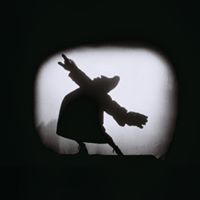
Les Mystères de la chambre noire: Photographic Surrealism, 1920-1950Summer closing from July 31—September 5 Exhibition reopening September 6—29 |
||
| Soichi Sunami, Object of Meret Oppenheim (fur-covered cup, saucer & spoon), 1936, Vintage gelatin silver print, 7 3/8 x 9 1/4 inches (18.7 x 23.5 cm), MoMA press photograph with multiple stamps & paper labels on verso | ||
| UBU GALLERY 416 EAST 59 STREET NEW YORK NY 10022 T: 212.753.4444 F: 212. INFO@UBUGALLERY.COM WWW. |
||
